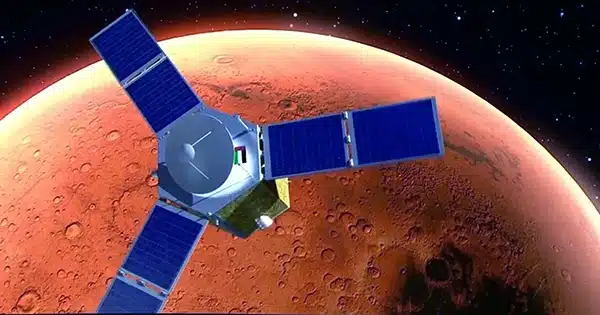APRIL 24, 2023, DUBAI (WAM) – In order to “advance our fundamental understanding” of Mars’ most mysterious moon and its larger companion, Phobos, the Emirates Mars Mission (EMM), the first interplanetary exploration project undertaken by an Arab country, has made a number of groundbreaking observations of Deimos, the smaller moon of Mars. The recent discoveries refute the conventional wisdom that the moons of Mars are captured asteroids and suggest that they have a planetary origin. The findings, which were presented today at a special session of the European Geosciences Union (EGU) General Assembly in Vienna, shed fresh light on the composition and structure of Deimos.
These include high-resolution images captured during the moon’s closest repeated flybys, as well as the first-ever observations in the extreme and far ultraviolet, as well as the first well-resolved hyperspectral data of Deimos in the thermal infrared. The findings show, for the first time, areas on the far side of Deimos that have never been explored in terms of composition. Hope passed within 100 kilometers of Deimos during the closest flybys.
Phobos and Deimos’ origins are unknown, according to Hessa Al Matroushi, the EMM Science Lead. “A long-standing view holds that they are asteroids that have been captured, although there remain unanswered concerns regarding their make-up. Any new knowledge we can gather about the two moons, especially the less frequently observed Deimos, has the potential to open up a new understanding of Mars’ satellites because how precisely they came to be in their current orbits is an active area of research. In contrast to the theory, our up-close observations of Deimos suggest a planetary origin rather than reflecting the makeup of a type D asteroid.

Early findings from EMIRS observations of Deimos tell a similar narrative to those obtained for Phobos, which show that its composition is not compatible with a captured D-type asteroid. Both of these bodies exhibit infrared characteristics that are more akin to a basaltic Mars than a D-type asteroid like the Taggish Lake meteorite, which is frequently used as a comparison for Phobos and Deimos’ spectral characteristics. said Christopher Edwards, instrument scientist at EMIRS.
Hope has made several close flybys of Deimos since transitioning to a modified orbit via a process known as a ‘Lambert transfer,’ a maneuver that subtly but significantly altered Hope’s orbital trajectory to allow Deimos observations while maintaining the mission’s ability to create planet-wide observations of Mars’ atmospheric dynamics.
“With these new observations, we have a unique opportunity with Hope to characterize the composition, thermophysics, and detailed geomorphology of Deimos,” said Justin Deighan, EMM Deputy Science Lead. “We expect to gain a better understanding of the origins and evolution of both Phobos and Deimos, as well as advance our fundamental understanding of these two Mars satellites.”
While both of Mars’ moons were found through telescopes in the 19th century, in-depth research wasn’t possible until the Space Age. Due to its smaller size and wider orbit, which it completes every 30 hours, Deimos is the less well-known and studied of the two moons. Phobos, its partner, is larger and circles Mars closer, making it easier for spacecraft to see it from Mars, where the majority of them are located at even lower altitudes. Hope’s very huge orbit around Mars, which was created to maximize coverage when investigating the atmosphere of the planet, provided a one-of-a-kind chance to examine Deimos in great detail.
Beginning in late January and early February 2023, Hope began its initial fly-bys of Deimos. From March forward, instrument calibration passes and near fly-bys supported high-quality photos and observations by the EXI, EMIRS, and EMUS equipment aboard Hope. Hope made the closest approach by a spacecraft to Mars’ smaller moon since the Viking mission in 1977 during the closest flybys, passing within around 100 kilometers of Deimos. Throughout 2023, Hope will maintain a consistent campaign of fly-bys of Deimos. The Emirates Mars Mission’s mission has been extended for an additional year, according to the UAE Space Agency, which is in charge of funding and managing it.
“The remarkable performance of the Mars Hope probe has supported a wide range of new observations in addition to meeting our originally stated science mission goals,” said Sarah Al Amiri, Chair of the UAE Space Agency. “During our cruise to Mars, we made new observations in collaboration with ESA/JAXA’s BepiColombo spacecraft, encapsulated a range of novel observations of Mars’ auroral displays, including never before observed aurora, and have now transferred our orbit to not only continue to support our unique observations of Mars’ atmosphere but also to make new observations of Deimos.” In the event that the Emirates Mars Mission exceeds all expectations, we will extend it for another year.”
Hope is presently maintaining its intended orbit of 20,000 to 43,000 kilometers in an elliptical shape with a 25-degree inclination toward Mars while making minor adjustments to facilitate its further Deimos studies. Throughout its mission to map Mars’ atmospheric dynamics, the probe completes one orbit of the planet every 55 hours and gathers a complete sample of planetary data every nine days.
The UAE’s spacecraft design, engineering, and manufacturing skills have been developed through a knowledge transfer and development program that began in 2006 and culminated with EMM and the Hope probe. Three sensors are aboard the completely autonomous spacecraft Hope, which is visiting Mars to examine its atmosphere. The spacecraft, which weighs around 1,350 kg and is about the size of a small SUV, was conceived and built by MBRSC engineers in collaboration with university partners such as LASP at the University of Colorado, Boulder, Arizona State University, and the University of California, Berkeley.
The Emirates Mars Mission is studying the Martian atmosphere and the relationship between the upper layer and lower regions, providing the international scientific community with a comprehensive view of the Martian atmosphere at various times of the day and throughout the seasons for the first time. Every three months, science data is released, and the material is made freely available to academics and fans worldwide.
















